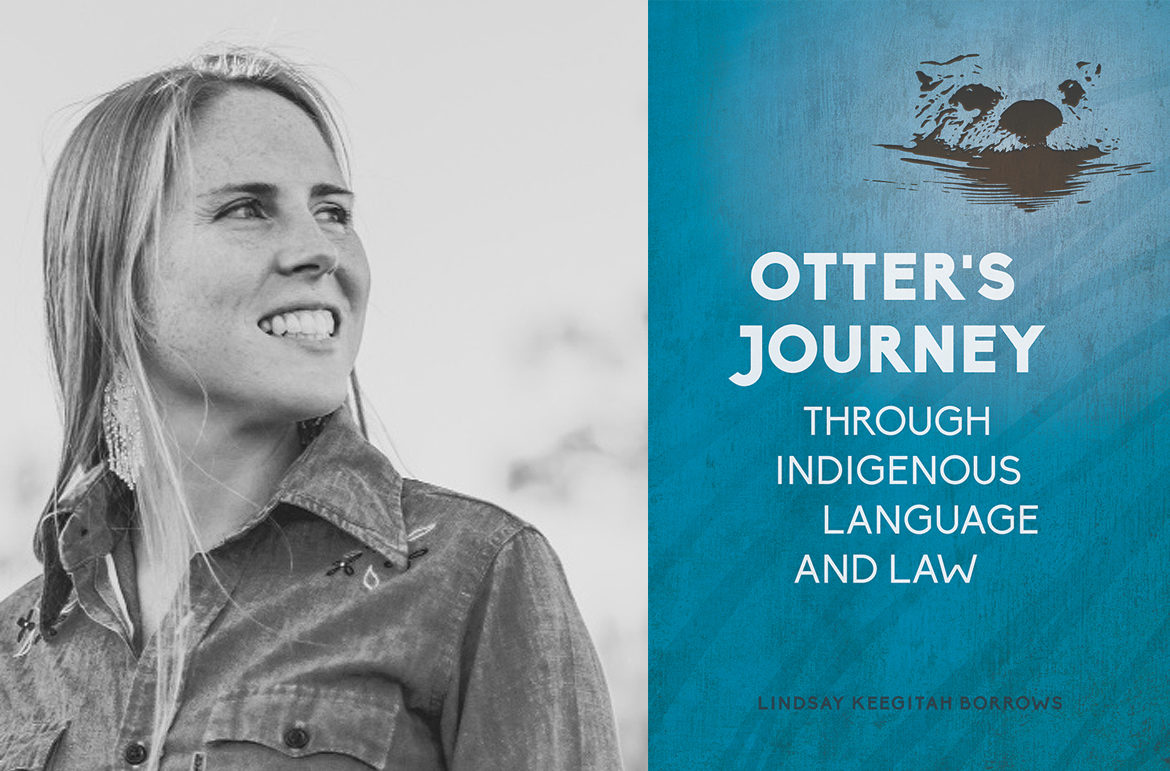Storytelling has the ability to share feelings and illuminate themes in a way that argument and theoretical exposition cannot. The tradition of storytelling is a deep-rooted part of Indigenous life, one which Lindsay Keegitah Borrows employs in her new book, Otter’s Journey through Indigenous Language and Law (UBC Press).
“Boozhoo nindinawemaaganidok, niiji-anishinaabeg, niiji-bimaadiziig. Nigig indodem. Keegitah indigo Anishinaabemong. Neyaashiinigimiing indonjibaa. Indabinoojiiwaadiz geyaabi. Gaawiin igo aapiji gegoo inkendanziin. Bangii eta go gegoo ningikendaan. Aapiji nimbagosendaan ji-bimaadizimagak geyaabi gidinawewininaan.
This introduction of myself is written in Anishinaabemowin, a language spoken by my ancestors and that remains the language of my nation – the Anishinaabe peoples of the Great Lakes region in North America. It reads, “Greetings to all of my relations, my fellow Anishinaabek, my friends. I am descended from the otter, my clan. My spirit name is Keegitah. I am from the place where the point of land narrows, Neyaashiinigmiing. I am still a child learning about our ways. I don’t know very much. I only know a little. I have a strong desire for our language to live on.”
Stories invite us to enter into different worlds. They can figuratively transport us from wherever we are – an apartment in a cold city or a patio in a desert village – to places we had never imagined. For example, a friend might say to you, “Did you hear about the old man that showed up in rural Ontario last week who spent the last eighty years living in an isolated shack in the woods with no one except his dog?” You might widen your eyes and respond, “Wow, I can’t imagine that.”
In order to more fully represent certain themes, ideas, and feelings, I stray from literal fact and blend worlds to allow the freedom to express myself and, I believe, others more completely.
The pedagogy of storytelling that I use to convey information is not trivial, childish, or taken lightly at Neyaashiinigmiing, my home on the unceded territory of the Chippewas of Nawash First Nation in what is now known as Southwestern Ontario. Different types of stories have different purposes. Some stories cannot be publicly shared. For example, sacred stories or stories owned by certain people, families, or clans with strict protocols have not been included. Others should only be told in certain seasons or places, or at certain times of the day.
Stories keep us alive as they emphasize a reality more profound than fact. They have the capacity to address feelings and demonstrate themes, to go beyond academic arguments and theoretical exposition. Cherokee author-trickster Thomas King has said, “The truth about stories is that’s all we are.”1 I chose to situate my writing in the realm of fiction because story is also connected to the Anishinaabe concept of debwe. In order to more fully represent certain themes, ideas, and feelings, I stray from literal fact and blend worlds to allow the freedom to express myself and, I believe, others more completely.
Storytelling is only one of many methods for learning and teaching important ideas. Language itself structures how we engage with ideas. For example, the Anishinaabe language (spoken mainly in the Great Lakes region of North America) has a unique way of framing the world. The sign of an eloquent speaker is not tied to efficiency in speech as it often is with English, but rather to how well one can create an image with her words. For blueberry pie, the Anishinaabe reservation of Leech Lake in northern Minnesota uses the following word – chigayatewemitigozhiminibaashkiminisaganibitosijiganizhegwaabikiniganibakwezhigan. This word creates an image of an old-time-stick waver/Frenchman-exploding-blueberries-blueberry-sauce-layered-between-thing-bend-over-and-put-it-in-the-oven-bread. A single word can tell a story. I try to use this image-oriented voice alongside the academic language throughout Otter’s Journey through Indigenous Language and Law, even when writing in English. Different languages sit together in this work to introduce you to the characters and themes associated with revitalizing and living Indigenous languages and laws.
I hope that these stories take care of you as they have me and through them, we can continue on our learning journey to (re)imagining a better earth.
Kichi miigwech”
—Lindsay Burrows
Otter’s Journey through Indigenous Language and Law by Lindsay Keegitah Borrows (UBC Press) employs the Anishinaabe tradition of storytelling to explore how Indigenous language revitalization can inform the emerging field of Indigenous legal revitalization. Borrows follows Otter, a dodem (clan) relation from the Chippewas of Nawash First Nation, on a journey across Anishinaabe, Inuit, Māori, Coast Salish, and Abenaki territories, through a narrative of Indigenous resurgence. Through her engaging protagonist, Borrows reveals that the processes, philosophies, and practices flowing from Indigenous languages and laws can emerge from under the layers of colonial laws, policies, and languages to become guiding principles in people’s contemporary lives. We need the best of all people’s teachings to lead us into the future.
Lindsay Keegitah Borrows is a staff lawyer at West Coast Environmental Law in Vancouver. She is Anishinaabe and a member of the Chippewas of Nawash First Nation in Ontario. Each fall in her home territory she helps run land-based Indigenous legal education camps for Ontario law schools. She has been a researcher at the Pascua Yaqui Tribal Court in Arizona, the United Nations, and the University of Victoria Indigenous Law Research Unit. She is a recipient of the Law Foundation of British Columbia Public Interest Award.
This essay was adapted by Lindsay Keegitah Burrows from the introduction to Otter’s Journey through Indigenous Language and Law. The book was published in Spring 2018 and the paperback is forthcoming this fall, September 1, 2018.
1. Thomas King, The Truth about Stories: A Native Narrative (Toronto: House of Anansi, 2003).

